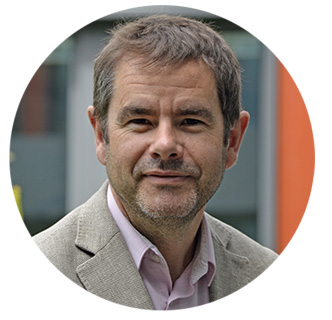Joint Interview with Sébastien Denys Director of the Environmental and Occupational Health Division at Santé publique France Éric Vial Risk Assessment Director at ANSES
Over the last few months, ANSES and Santé publique France have been actively finalising the launch of Albane. This major national survey will collect data on health, chemical exposure, food consumption and physical activity over two-year cycles, based on representative samples drawn from the population, from birth to 79 years of age. Funded by the Ministries of Health, the Environment, Agriculture and Labour, Albane will support both agencies’ missions and generate useful indicators for monitoring the effectiveness of public policies in the fields investigated.
Other nationwide population studies were carried out by ANSES and Santé publique France before Albane. What were they?
 ÉRIC VIAL. ANSES has a number of major studies to its credit, which have analysed and estimated the health risks associated with the various contaminants found in food, and assessed the nutritional
ÉRIC VIAL. ANSES has a number of major studies to its credit, which have analysed and estimated the health risks associated with the various contaminants found in food, and assessed the nutritional
risks and benefits of different consumption practices. Exploring the population’s dietary habits and
nutritional status is necessary to better explain and prevent certain non-communicable diseases such
as cancer, obesity and cardiovascular disease.
ANSES carried out its individual and national studies on food consumption (INCA) at eight-year intervals, the last of which was finalised in 2015. Our Agency has also conducted total diet studies (TDSs) to monitor population exposure to chemicals found in food. These major studies provide invaluable data for carrying out our risk assessments and enabling the health authorities to adapt the public health measures taken with regard to food.
 SÉBASTIEN DENYS. Santé publique France is responsible for monitoring the health of the French population.
SÉBASTIEN DENYS. Santé publique France is responsible for monitoring the health of the French population.
To do this, it deploys a range of tools, including surveys with health examinations. An example is the Esteban survey, which was conducted between 2014 and 2016 on a representative sample of the general population aged between six and 70 years. It collected various health indicators (asthma, allergies, cardiovascular disease, etc.) and data on chemical exposure of the French population. The results on exposure to chemicals via food were cross-referenced with ANSES’s INCA and TDS findings, enabling a more detailed interpretation
of the exposure levels measured, given that food is a major source of exposure to a number of chemical contaminants. Generally speaking, these major surveys make it possible to monitor the population’s exposure over time and
measure the effectiveness of the public policies deployed.
Albane follows on from the Esteban and INCA studies and goes
further than a simple merger of the two. What else will it bring?
ÉRIC VIAL. The project was launched in 2018. It has a number of objectives, one of which is to strengthen the sharing and cross-referencing of data between agencies, thereby increasing efficiency in the study of the links between individual, dietary and environmental determinants and population health. It is also designed to spread the monitoring and workload more evenly
over time. With shorter consecutive cycles – two years compared with eight for the Esteban and INCA studies – Albane provides
greater flexibility for studying trends and emerging phenomena, in terms of exposure or diseases.
SÉBASTIEN DENYS. Combining our studies made sense and had a number of advantages. Besides the obvious benefit of optimising resources, it will help ensure the long-term viability of a survey system requiring substantial sums and mobilisation of teams in both of our agencies. Moreover, we are bringing Albane in line with internationally recognised standards and systems used in other countries (Germany, Canada, United States), enabling us to make comparisons with measures taken internationally.
In 2025, the study will cover metropolitan France, and there are plans to include the overseas territories from 2028. Lastly, by
sampling the same regions several times over the course of different cycles, we will eventually be able to estimate certain survey indicators on a regional scale and then support public health policies at a more local level, which is not possible with Esteban, for example.
How will it take place in practice?
ÉRIC VIAL. ANSES will be responsible for the food component of the study, and Santé publique France for the biomonitoring and
health component, both in terms of drawing up the survey protocols and analysing the data. Questions of nutrition will be shared between the two agencies. Santé publique France will also be responsible for logistical implementation of the survey and for liaising with the research institute tasked with recruiting participants. Before launching the first cycle, we will begin with a pilot phase. This is scheduled to take place between September and December 2024, and will involve around 200 people selected at random. It will enable us to measure the participation rate, and test the questionnaires and the organisation in general. We will then have a few months to adjust the system before the launch of the study scheduled for spring 2025.
SÉBASTIEN DENYS. Albane has no equivalent in France. We are looking for the best response possible from participants, as this is essential if we are to have high-quality monitoring data that cover all the survey parameters. We have therefore done all we can to make participation easier, for example by using appropriate tools such as self-administered questionnaires. Albane poses a number of legal, administrative and IT challenges, such as ensuring compliance with GDPR rules, data security, the robustness
of statistics, compliance of data flows with service providers, etc. We have had to be inventive and find answers to questions
that had not previously arisen. This collaboration between agencies will enable us to go even further and better reflect the reality of population health.